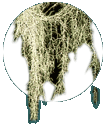
|
 |
Usnea Lichens
Have you ever looked at orange patches on trees or yellow patches on rocks without knowing quite what you were seeing? Would you believe a mutant worthy of a B-grade science fiction movie? Or a practical housekeeping material? A life-saving medicine, a scientific tool, or food? Museum Research Scientist Irwin Brodo explains the unusual and useful characteristics of lichens of the genus Usnea. |
Arctic Lupine, Lupinus arcticus
Lupinus arcticus is one of Mike Shchepanek's favourites. Until he retired, Mike was the Chief Collections Manager for Nature's botany section; he remembers an exciting growth experiment conducted 31 years ago on 10,000-year-old seeds. |
 |
 |
Purple Saxifrage, Saxifraga oppositifolia
One of Nature's botanists, Susan Aiken, has selected this plant as one of our amazing treasures because it is one of only four flowering plants that grow on the northernmost land on Earth. It is well known to people of the Northwest Territories as the first flower of spring. |
|
|

